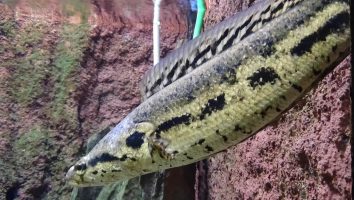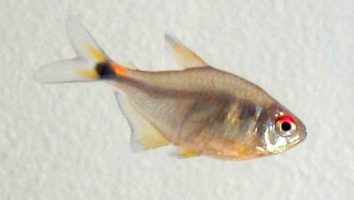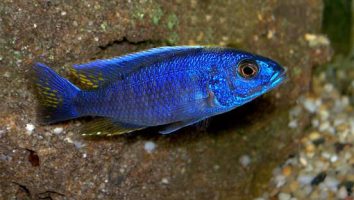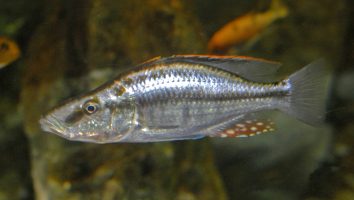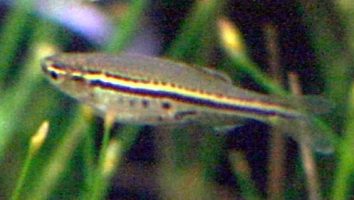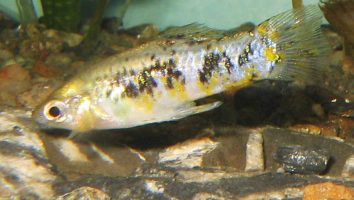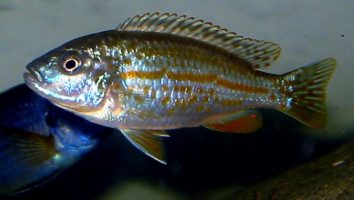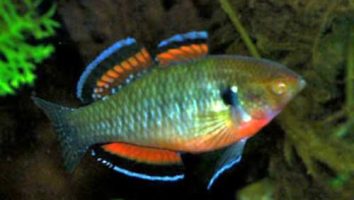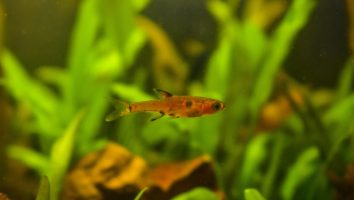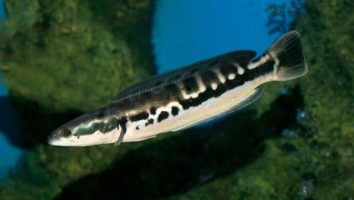The jaguar cichlid is a large, predatory fish that is native to Central America. They are one of the most popular cichlids in the aquarium trade and are prized for their unique coloration and patterning.
Despite their popularity, jaguar cichlids are not a beginner-friendly fish. They require a large tank, robust filtration, and a carefully planned diet.
This guide will teach you everything you need to know about jaguar cichlid care. You’ll learn about their diet, size, lifespan, and more!
Table of contents
Species overview
The Jaguar cichlid (scientific name: Parachromis managuensis) is a fish that’s native to Central America, specifically in areas like Nicaragua and Costa Rica.
They tend to inhabit slow-moving rivers and lakes. These bodies of water are typically heavily vegetated with a lot of hiding places for the fish.
The jaguar cichlid is a large fish, growing up to two feet in length in the wild. They are carnivorous and will eat just about anything they can fit in their mouth. This includes other fish, invertebrates, and even smaller mammals if they’re available.
Due to their size and aggression, jaguar cichlids are not recommended for novice aquarium owners. They require a lot of space and can be quite destructive. However, for experienced aquarists, they can be a beautiful and exciting addition to the tank.
Appearance
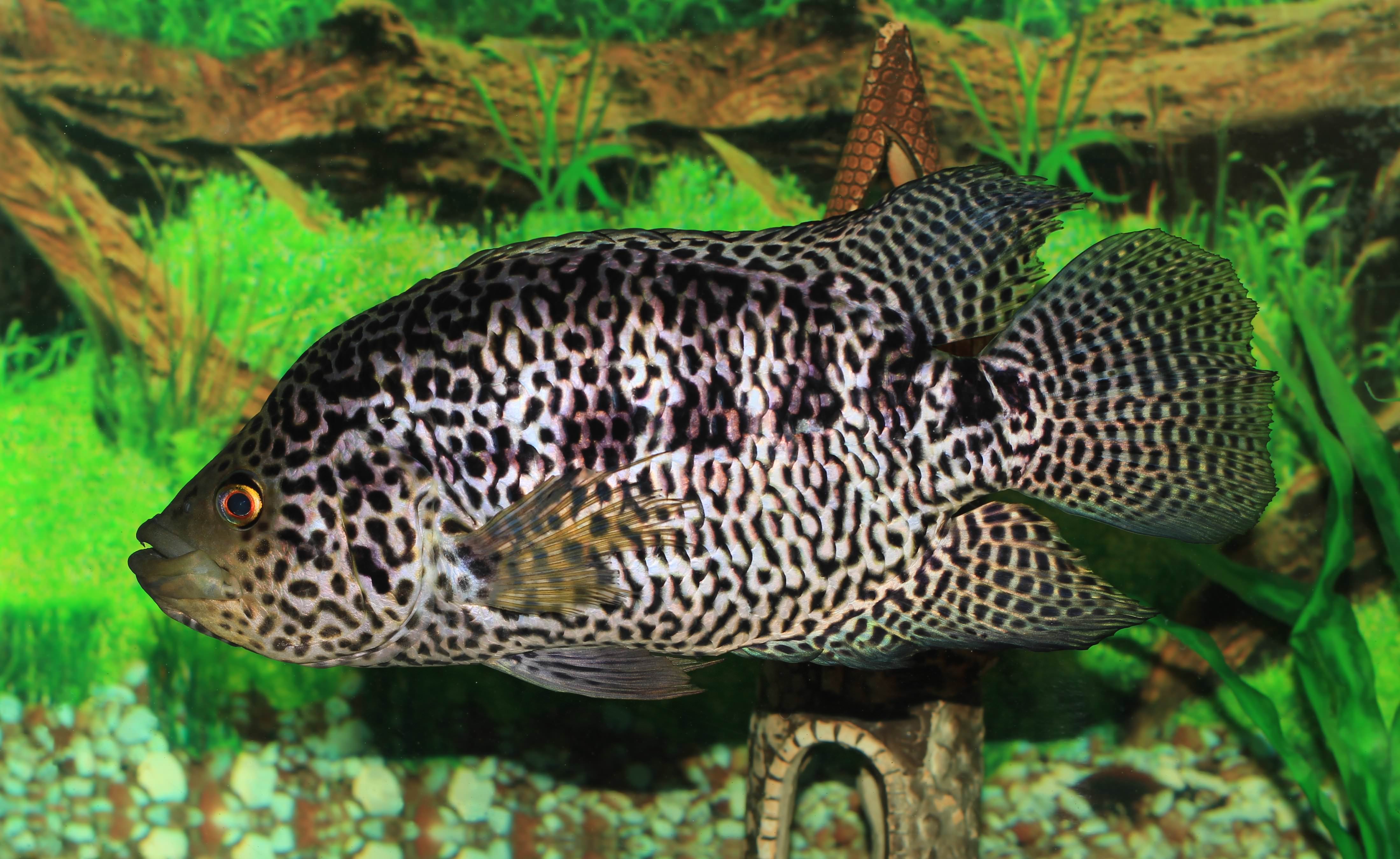
The Jaguar cichlid is one of the most popular freshwater aquarium fish for a reason: they’re absolutely gorgeous.
These fish have a unique coloration that is really unrivaled in the freshwater world. The base color of the fish is a light silver that is covered in black spots.
The spots on these fish are unique in that they are circular and have a light “halo” around them. This gives them a very striking appearance that is really eye-catching.
The Jaguar cichlid also has a very unique body shape that adds to their appeal. These fish are very tall and thin, almost to the point of looking skeletal.
Their dorsal and anal fins are very long and extend almost the entire length of their bodies. The fins themselves are covered in the same black spots as the rest of their bodies.
The caudal fin is forked and also covered in spots. The pectoral fins are large and also have spots. The only fins that don’t have spots are the ventral fins, which are very small.
Lifespan
The average lifespan of a Jaguar cichlid is 10 to 12 years. However, there have been reports of these fish living up to 20 years in captivity.
As with all fish, the lifespan of a Jaguar cichlid can be impacted by a number of different factors. Things like water quality, diet, and stress can all shorten their lifespan.
Size
The Jaguar cichlid is a large fish that can reach up to 2 feet in length, although the average size is closer to 1 foot. These fish are also quite stocky and can weigh up to 10 pounds.
Tank
Tank Size
The recommended tank size for a single Jaguar cichlid is 125 gallons. If you’re looking for a smaller freshwater fish, this is not the fish for you.
If you want to keep two Jaguar cichlids in the same tank you’ll want to add at least another 125 gallons to that minimum number if you want them to thrive.
Another reason why you need to provide enough space is for the sake of enrichment and comfort. These fish like to roam and will often run gentle but steady laps around your tank. Giving them a little bit of extra space can go a long way in making sure they can comfortably turn around in the tank.
Water Parameters
Jaguar cichlids are a bit more demanding when it comes to water parameters. They come from Central America, which means they prefer warm water with a high alkalinity.
You’ll need to maintain a consistent water temperature between 78 and 86 degrees Fahrenheit. The pH should be between 7.0 and 8.0, and alkalinity should be between 10 and 20 dKH.
Water hardness isn’t as critical, but you should aim for a range between 10 and 20 dGH.
One important note about Jaguar cichlid care is that these fish are known to be aggressive. They can be kept with other cichlids, but you need to be very careful about tank mates. Avoid anything that’s small enough to be considered prey.
You should also have plenty of hiding spots and caves for the Jaguar cichlid to retreat to when it feels threatened.
What To Put In Their Tank
Jaguar cichlids are one of the most popular freshwater fish for a reason. They’re beautiful, unique, and relatively easy to care for.
One important aspect of their care is providing them with an enriching habitat. A big part of this is the plants you choose to put in their tank.
Jaguar cichlids are known to be a bit on the destructive side. Their size and activity level means they can easily uproot or damage plants.
For that reason, we recommend avoiding anything too delicate. Hardy plants like Java Fern or Anubias are a good choice. You can also go with floating plants to help diffuse the light and provide some cover for your fish.
The substrate in their tank should be soft to avoid any injuries. A sandy bottom is ideal, but you can get away with a gravel substrate as well. Just avoid anything too sharp or jagged.
Decorations are another important aspect of their habitat. We recommend including some driftwood or rocks to help provide hiding places and create some visual interest.
Just avoid putting anything too small in their tank. These fish are known to eat decorations if they’re small enough to fit in their mouths!
Common Diseases
The Jaguar cichlid is a pretty hardy fish, but that doesn’t mean they can’t get sick. In fact, there are a few diseases that seem to plague this species more than others.
The most common disease that affects Jaguar cichlids is Hole in the Head disease. This is a pretty serious illness that can cause pretty severe damage to your fish if it’s not treated quickly.
Hole in the Head disease is caused by a number of things, but the most common culprit is poor water quality. This disease will present itself as pits or holes in the skin of your fish’s head.
While this disease is usually curable, it will often leave scars on your fish. The best way to prevent this disease is by maintaining excellent water conditions in your tank.
Another disease that affects Jaguar cichlids is ich. This is a pretty common freshwater disease that can affect any number of fish species.
This disease will present itself as white spots on the body, fish, and gills of your fish. Ich is pretty easy to treat if it’s caught early, but it can be pretty serious if it’s left untreated.
The best way to prevent ich is by maintaining excellent water conditions in your tank.
Behavior & Temperament
The Jaguar cichlid is a beautiful, but aggressive fish. It is not recommended for beginners. In the wild, these fish are known to be very territorial. They will defend their space with their lives. The same is true in aquariums.
Jaguar cichlids are not known for being shy. They are confident and will let you know exactly how they feel. If they’re unhappy, they will let you know with their aggressive behavior.
These fish need a lot of space. They are active swimmers and need room to move. If they feel cramped, they will become even more aggressive.
Jaguar cichlids are also known to be nippy. They will often bite at other fish and even their owners. They are not recommended for households with small children.
Overall, the Jaguar cichlid is a beautiful, but difficult fish to keep. They are not recommended for beginners.
Tank Mates
The jaguar cichlid is a large, predatory fish. It’s not the type of fish that you can stick in a community tank and hope for the best.
To make things worse, these fish are highly territorial. They need a lot of space to themselves, and they’re not afraid to defend their turf.
The jaguar cichlid is also known to be aggressive towards tank mates. This is especially true when they’re spawning.
For these reasons, it’s important to be very careful when choosing jaguar cichlid tank mates. The best tank mates for jaguar cichlids are other large, predatory fish.
Some good options include:
- Oscar Fish
- Green Terror Cichlid
- Convict Cichlid
- Blood Parrot Cichlid
- Jack Dempsey Cichlid
- Firemouth Cichlid
- Texas Cichlid
Breeding
Jaguar cichlids are mouthbrooders, which means that the female will carry the eggs and fry in her mouth until they are ready to be released into the world.
The first step in breeding these fish is to identify a male and female. The easiest way to do this is by looking at their coloration. Males are usually more brightly colored than females.
Once you have your pair, you need to set up a breeding tank. The tank should be at least 50 gallons and have plenty of hiding places.
Plants are not necessary, but if you decide to use them make sure they are well-secured. Jaguar cichlids are known for their digging habits and will uproot anything that’s not bolted down.
The water conditions in the tank are also important. The pH should be between 7.0 and 8.0 and the water should be on the hard side.
When everything is ready, you can add your pair to the tank. The male will start to build a nest out of sand or small rocks. Once the nest is complete, the female will lay her eggs.
The male will then fertilize them and the female will pick them up in her mouth. She will carry them around for about three weeks before releasing them into the world.
Once the fry are released, you can feed them baby brine shrimp or other small live foods. They will grow quickly and will be ready to be moved to a larger tank in no time.
Conclusion
The Jaguar Cichlid is a beautiful and unique fish that is sure to turn heads in your local fish store. They’re also a blast to keep and are very rewarding fish to care for.
However, they’re not the best fish for beginners. They can be aggressive and need a lot of space. They also require a little bit more care than some of the other fish on this list.
But if you’re up for the challenge, we think you’ll be very happy with your decision to add a Jaguar Cichlid to your tank!

